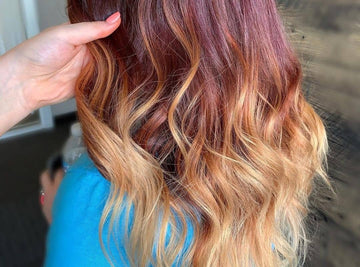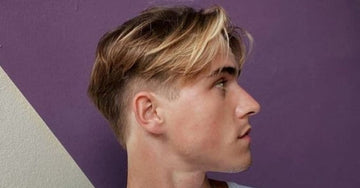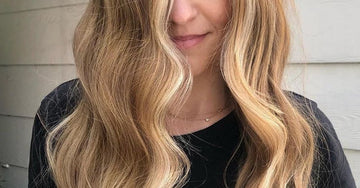Yes, we know how many people are very interested in coloring their hair with various colors, but they also didn’t know that these dyes can also make your hair itchy afterwards. Many but not all hair dyes can cause your scalp to itch and don’t worry because it’s common!
This usually happens when the dye is sitting on your hair for too long. Hair dyes contain allergy-inducing chemicals that can trigger your scalp when the hair dye is applied. the most common allergen from dyes are called Para-phenylenediamine (PPD).
How to Treat an Itchy Scalp After Hair Coloring
If you want to color your hair so badly, but you also know that you have very sensitive skin, here are some of the ways that you can treat your itchy scalp after coloring your hair.
Patch test
Patch test is one of the best ways to know if your skin would be allergic to certain hair coloring products is through a patch test. You have to remember that most hair coloring products that you get from stores and even salons contain allergens like Para-phenylenediamine (PPD).
Allergens can cause dermatitis on your scalp, so you can try putting a little bit of the dye on your skin. the most convenient place to have a patch test is behind your ears. Wait for a few minutes, then see if your skin negatively reacts to the product.
It is always best to do a patch test one to two days before fully dyeing your hair. You won’t want to be scratching your entire head during the big day, right?
Wash Your Hair with Gentle Products
So, now that you have achieved your dream hair color, and you feel like your scalp is annoyingly itchy afterwards, don’t worry! One great way to get rid of the itchiness is to gently and thoroughly wash your hair with an extra gentle shampoo like the MOPTOP Gentle Shampoo.
This shampoo offers you gentle cleansing while hydrating your hair after the strenuous bleaching and dyeing. the MOPTOP Gentle Shampoo is also perfect for any type of hair and texture.
Another tip is to skip using harsh products like dry shampoos, hair sprays, leave-in conditioners and the like. These products are high in chemicals that may irritate your scalp while it’s still healing.
Moisturize and Hydrate your Hair
We mentioned that it is vital to gently and thoroughly cleanse your hair after dyeing, but make sure to apply some hydrating conditioner afterwards. Keeping your scalp and hair hydrated through the help of Aveeno Rose Water & Chamomile Blend Sulfate-Free Conditioner can be a great move.
This conditioner is ideal for people who have very sensitive skin. One of its core ingredients is oat, which is known for its soothing properties on the skin and scalp. After cleansing your hair, you would feel the mild rose water and chamomile that leaves your hair super soft and smooth.

Another thing to consider is the dryness of the scalp after dyeing. If you happen to experience these after your hair coloring session, you can also try using coconut oil to add moisture and hydration on your scalp.

Skip the Heat
When you have irritated and sore scalp from hair coloring, you might want to skip hair styling using heated equipment. Stay away from applying direct heat from flat irons or blow dryers when your scalp is still healing.
This might be a little difficult to do, especially during the winter months. But you can try using a blow dryer on the tips of your hair when it’s at least 80% dry. Make sure to stay away from the scalp to lessen the irritation caused by hair coloring.
You can also use a heat protection spray like the L’Oréal Paris Advanced Hairstyle Sleek It Iron Straight Heat Spray. Aside from giving you the utmost protection from heat damage and irritation, this hair spray can also calm the frizz from your newly bleached hair. Make sure to only apply the spray on your strands to prevent your scalp from getting irritated and itchy.

Wait it Up!
Just like regular wounds, your scalp also needs to heal. So, wait for a few days and allow your scalp to go back to its normal state. On the other hand, if you are still experiencing intense irritation after 5 to 7 days, it is highly recommended to visit your dermatologist for further interventions.
Use Dyes for Sensitive Skin
Did you know that there are also dyes that are crafted for sensitive skin? There are dyes that allow you to enjoy having vibrant hair colors without leaving your skin wounded and itchy afterwards.
You would love the Hair Speedy Hair Dyes that are free from PPDs. In addition to that, this brand is also free from ammonia and it is odorless too!
Another great thing about this product is that it also takes less time to pigment your hair unlike regular hair dyes. Common hair color products usually take up to 60 minutes to complete the coloring process, but this only takes 20!
You no longer have to worry about sun damage too, since this Speedy Hair Dye is accompanied with sunlight protection. Basking under the sun with your new hair can now be possible, thanks to this coloring product.

Hair Dye Allergy Symptoms
Don’t ever neglect your itchy scalp after hair coloring because this can be one of the signs that you have hair dye allergy. the symptoms may occur within or after 48 hours after you have colored your hair.
Here are some of the symptoms that you should look out for:
- Burning sensation on the scalp, face, and neck
- Swelling of hands, lips, eyelids, and face
- Red rash anywhere on the body
- Blisters
For some people, anaphylaxis, a life-threatening allergic reaction, can occur even with a simple hair dyeing session. Here are some of the symptoms of anaphylaxis relative to hair dyes:
- Skin reactions like blistering, burning, swelling
- Swollen throat and tongue
- Difficulty breathing
- Fainting
- Nausea
- Dizziness
- Vomiting
It is crucial to take the person experiencing an anaphylaxis reaction to the emergency room immediately, or call 911.
What are hair dye ingredients that cause itchiness?
Aside from the very popular PPD mentioned above, there are also other variations of this chemical and other ingredients that can cause itchiness and allergic reactions. Don’t be fooled with “organic” or “herbal” hair dyes, as they can still contain some ingredients that can make you scratch all night after dyeing your hair.
Take a look at some of the ingredients that can cause allergies below:
- phenylenediamine
- paraphenylenediamine
- PPD
- PPDA
- p-diaminobenzene
- p-phenylenediamine
- 4-phenylenediamine
- 4-aminoaniline
- 1,4-diaminobenzene
- 1,4-benzenediamine
You must know that black and brown-colored dyes contain the most amount of PPDs, so you might want to avoid them if you are allergic to hair dyes.
Another thing to remember is that it is not only PPDs that cause itchiness and allergies, but some people can also react negatively with ammonia, peroxide, and resorcinol.
Treating an allergic reaction from hair dye
If you are experiencing allergic reactions after coloring your hair, here are some tips and recommendations on treating it:
- If you notice an immediate reaction even after a few minutes of applying your hair dye, the first thing you should do is to wash the dye off of your hair. Warm water and a mild shampoo should do the trick.
- Shampoos that contain corticosteroids can also help in combating the allergic reaction.
- Simple compresses of olive oil and lime can also help relieve itching from the hair dye.
- Create a solution of 2% hydrogen peroxide to oxidize the PPD on the hair dye. Hydrogen peroxide is also very effective in calming the skin while also reducing the inflammation and itchiness.
- Oral antihistamines can also help alleviate the symptoms of the allergic reaction.
General Precautions to Prevent Itchy Scalp When After Hair Coloring
Now that we have learned everything about hypersensitivity to hair dyes, here are the takeaways to prevent your scalp from itching after hair coloring.
- Read Instructions: Always check how to use a certain dye to ensure that you are following the correct and safest procedure for your hair color.
- Don’t leave dye beyond recommended time: Hair dye packages contain a specific time where you need to leave the dye on your hair. Make sure to never leave the dye for too long on your hair and scalp to prevent irritations
- Use gloves: It is not only your scalp that can be prone to irritations from hair dyes, but also your precious hands. Always remember to use gloves every time you apply hair dye and bleach.
- Wash your hair thoroughly: Some people tend to forget to wash their hair thoroughly after dyeing. Don’t get too excited about seeing your new hair color, and always make sure that every strand of the hair is thoroughly washed and rinsed. the allergy-inducing chemicals might still be present on your scalp that can cause irritation.
Read More:
Is a Wet to Dry Straightener Bad for Your Hair?






